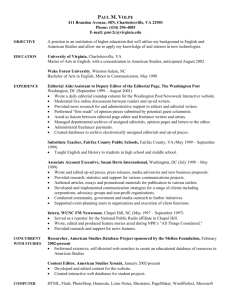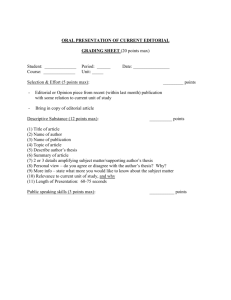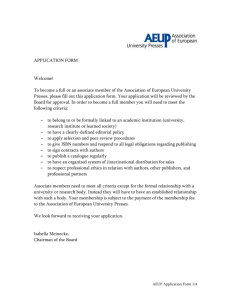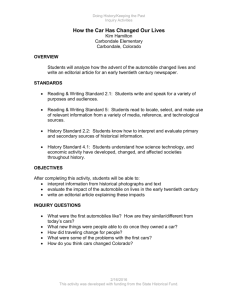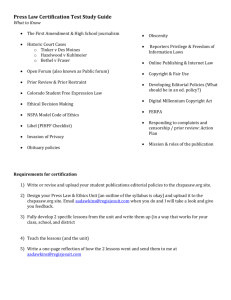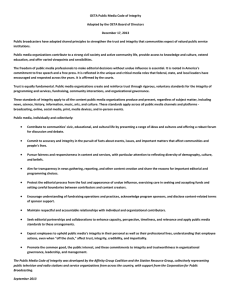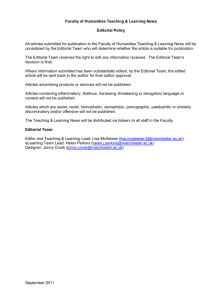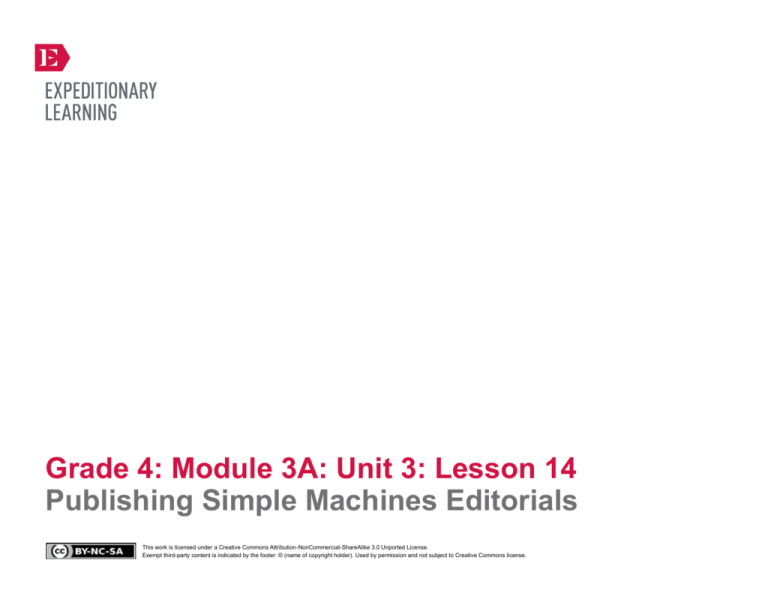
Grade 4: Module 3A: Unit 3: Lesson 14
Publishing Simple Machines Editorials
This work is licensed under a Creative Commons Attribution-NonCommercial-ShareAlike 3.0 Unported License.
Exempt third-party content is indicated by the footer: © (name of copyright holder). Used by permission and not subject to Creative Commons license.
GRADE 4: MODULE 3A: UNIT 3: LESSON 14
Publishing Simple Machines Editorials
Long-Term Targets Addressed (Based on NYSP12 ELA CCLS)
I can write an opinion piece that supports a point of view with reasons and information. (W4.1)
I can use grammar conventions to send a clear message to a reader or listener. (L.4.1, L.4.2)
With support, I can use technology to publish a piece of writing. (W.4.6)
Supporting Learning Targets
Ongoing Assessment
• I can write an editorial stating my opinion on which simple machine benefits people the most in their
everyday lives.
• Simple Machine Editorial (final copy)
• I can correct conventions based on editing notes in my editorial and online reference resources.
• I can publish a typed version of my simple machine editorial.
Copyright © 2013 by Expeditionary Learning, New York, NY. All Rights Reserved.
NYS Common Core ELA Curriculum • G4:M3A:U3:L14 • June 2014 •
1
GRADE 4: MODULE 3A: UNIT 3: LESSON 14
Publishing Simple Machines Editorials
Agenda
Teaching Notes
1. Opening
• This lesson is very similar to Module 2A, Unit 3, Lesson 15.
A. Reviewing Learning Targets (5 minutes)
2. Work Time
A. Modeling: Using Technology to Publish (10
minutes)
B. Independent Work and Conferring (40 minutes)
3. Closing and Assessment
A. Debrief (5 minutes)
4. Homework
A. Prepare for your assessment by:
1. Reviewing the notes in your Simple Machines
science journal.
2. Thinking about the simple machines you researched
but did not write about. Brainstorm some reasons
that each of these simple machines could be
considered “the most helpful.”
• This lesson is largely dependent on each student having access to a computer, online dictionary, and a
printer. If students have already been able to type their second draft on the computer, the timing of this
lesson will work well. If students have not yet started typing, consider giving them additional time to
word-process their final copies.
• Please bear in mind that website links may incorporate inappropriate content via comment banks and
ads. While some lessons include these links as the most efficient means to view content in preparation
for the lesson, be sure to preview links, and/or use a filter service, such as www.safeshare.tv, for actually
viewing these links in the classroom.
• If your class lacks sufficient technology, consider modifying this lesson to use standard print
dictionaries and focus students on using neat handwriting to create a polished final copy of their
editorials.
• Students may need additional time for typing.
• In advance: Prepare the Steps for Publishing My Editorial chart (see supporting materials).
3. Reviewing the Simple Machines Editorial rubric.
Copyright © 2013 by Expeditionary Learning, New York, NY. All Rights Reserved.
NYS Common Core ELA Curriculum • G4:M3A:U3:L14 • June 2014 •
2
GRADE 4: MODULE 3A: UNIT 3: LESSON 14
Publishing Simple Machines Editorials
Lesson Vocabulary
Materials
publish (review from Module 2A, Unit
3)
• Teacher computer
• LCD projector
• Printer and printer paper
• Online dictionaries such as www.dictionary.com or http://www.wordcentral.com/
• Simple Machines Editorial rubric (completed in Lesson 13 and typed; one per student)
• Prepared on chart paper: Steps for Publishing My Editorial chart (see supporting materials)
• Computers for students (see teaching notes)
Meeting Students’ Needs
Opening
A. Reviewing Learning Targets (5 minutes)
• Introduce the learning targets. Circle the word publish and ask students to turn to a partner and share what they remember
about this word and its meaning from writing their historical fiction narratives (Module 2A, Unit 3). Call on a few students
to share their partner’s thinking.
• Ask:
* “What references can you use to check the meaning of this word?”
• Some answers might include: dictionary, Google, peers, or the teacher. Tell them that today they will again practice using a
computer as both a reference and to publish their editorials.
Copyright © 2013 by Expeditionary Learning, New York, NY. All Rights Reserved.
NYS Common Core ELA Curriculum • G4:M3A:U3:L14 • June 2014 •
3
GRADE 4: MODULE 3A: UNIT 3: LESSON 14
Publishing Simple Machines Editorials
Work Time
Meeting Students’ Needs
A. Modeling: Using Technology to Publish (10 minutes)
• Ask students to sit where they can see the projection of your computer. Let them know that today is the day they prepare
their work to make it public—in other words, to publish it.
• If using a conventional printed
dictionary, you may want to review
searching for a word using
alphabetical order.
• Project an online dictionary such as www.dictionary.com or www.wordcentral.com. Tell students that you are going to
use this online resource to check their thinking about the word publish. Type the word “publish” into one of the online
dictionaries and read the definitions. Read the definition to the class and have students turn to a partner and explain what it
means to publish something in their own words. Have a few pairs share their thinking.
• Set purpose: Remind students that they will be sharing their published editorials with an audience, their classmates. Tell
them that in order to publish their editorials, they need to be sure everything is complete and correct. Today they will have
time to polish their writing. Remind them that they now have an edited draft complete with their revised beginning and
ending. It is on this draft that they will correct their conventions.
• Demonstrate how to use the online dictionary for misspellings. Show students how to scroll down and check for possible
correct spellings by checking the definitions.
• If possible, expand the audience to
include others who are not a part of
the class (i.e., teachers, principal,
parents, other classes). This can be
motivating and exciting for
students. See recommendations in
Lesson: Reflecting on Writing
Editorials: Author’s Chair in the
teaching notes.
• Distribute the now typed version of the Simple Machines Editorial rubric. Explain to students that you have taken the
rubric anchor chart and typed it up for their reference as they prepare to publish.
• Post the Steps for Publishing My Editorial chart.
1. Read your draft and correct conventions based on editing notes.
2. Check your editorial one last time using the Simple Machines Editorial rubric.
3. Type up your draft to include all corrections and revisions.
B. Independent Work and Conferring (40 minutes)
• Have students move to a computer to begin work following the Steps for Publishing My Editorial chart.
• Confer with students as needed and when they decide they are finished.
Note: Ask students to add a footer to their paper with their full name. This avoids confusion when they print their papers.
• Some students who have difficulty
spelling may have a hard time
finding the correct spellings for
severely misspelled words. Keep
these students in mind for
conferring.
• Depending on pace, students may
need additional time for typing.
Copyright © 2013 by Expeditionary Learning, New York, NY. All Rights Reserved.
NYS Common Core ELA Curriculum • G4:M3A:U3:L14 • June 2014 •
4
GRADE 4: MODULE 3A: UNIT 3: LESSON 14
Publishing Simple Machines Editorials
Publishing Simple Machines Editorials
Meeting Students’ Needs
Closing and Assessment
A. Debrief (5 minutes)
• Gather students whole group. Review the learning targets. Tell them that in the next lesson, they will get to demonstrate
their ability to write editorials in an on-demand assessment. This means they will take all of the skills and knowledge they
have gained over the past several weeks to plan and write another editorial on a different simple machine. Instead of having
several weeks to write and revise, they will be asked to do this in one class period.
• Assure them that they are ready for this “on my own” assessment. They have just finished their editorials and now should be
experts on this genre of writing. They will be able to use their Simple Machines science journals, the text Simple Machines:
Forces in Action, and the Simple Machines Editorial rubric to help them.
• Explain that in the lesson that follows the assessment, they will celebrate their learning as readers, researchers, and writers
by sharing their published editorials in an activity called Author’s Chair Celebration. Tell them that they will be reading
these published editorials to one another and reflecting on the writing process.
Meeting Students’ Needs
Homework
• Prepare for your assessment by:
1. Reviewing the notes in your Simple Machines science journal.
2. Thinking about the simple machines you researched but did not write about. Brainstorm some reasons that each of these
simple machines could be considered “the most helpful.”
3. Reviewing the Simple Machines Editorial rubric.
Copyright © 2013 by Expeditionary Learning, New York, NY. All Rights Reserved.
NYS Common Core ELA Curriculum • G4:M3A:U3:L14 • June 2014 •
5
Grade 4: Module 3A: Unit 3: Lesson 14
Supporting Materials
This work is licensed under a Creative Commons Attribution-NonCommercial-ShareAlike 3.0 Unported License.
Exempt third-party content is indicated by the footer: © (name of copyright holder). Used by permission and not subject to Creative Commons license.
GRADE 4: MODULE 3A: UNIT 3: LESSON 14
Steps for Publishing My Editorial Chart
(Directions for teacher: Prepare a chart paper with the following directions for students.)
Steps for Publishing My Editorial
1. Read your draft and correct conventions based on editing notes.
2. Check your editorial one last time using the Simple Machines Editorial Rubric.
3. Type up your draft to include the corrections and revisions.
Copyright © 2013 by Expeditionary Learning, New York, NY. All Rights Reserved.
NYS Common Core ELA Curriculum • G4:M3A:U3:L14 • June 2014 •
7


